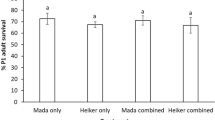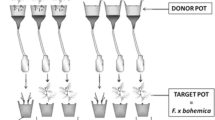Abstract
Invasive plants are by definition excellent competitors, either indirectly through competition for resources or directly through allelopathic inhibition of neighboring plants. Although both forms of competition are commonly studied, attempts to explore the interactions between direct and indirect competition are rare. We monitored the effects of several doses of extracts of Alliaria petiolata, a Eurasian invader in North America, on the growth of Impatiens pallida, a North American native, at several planting densities. The density-dependent phytotoxicity model predicts that as plant density increases, individual plant size will decrease, unless a toxin is present in the soil. In this case, individual plant size is predicted to increase as plant density increases, as plants share a limited toxin dose. We tested this model using fractions of an A. petiolata extract enriched in flavonoids or glucosinolates, as well as a combined fraction. The flavonoid-enriched fraction and the combined fraction suppressed I. pallida growth but only when applied at a dose eight times higher than that expected in the field. When treated with a dose equivalent to estimated field exposure levels, I. pallida growth was not distinguishable from that of control plants that received no extract, showing that indirect competition for resources was more important for determining the growth of I. pallida than direct allelopathic inhibition by A. petiolata. This is an important reminder that, even though many plants have the demonstrated potential to exert strong allelopathic effects, those effects may not always be apparent when other forms of competition are considered as well.




Similar content being viewed by others

References
Andersen, R. N. 1981. Increasing herbicide tolerance of soybeans (Glycine max) by increasing seeding rates. Weed Sci. 29:336–338.
Barto, E. K. and Cipollini, D. 2009. Half-lives and field soil concentrations of Alliaria petiolata secondary metabolites. Chemosphere. doi:10.1016/j.chemosphere.2009.02.020
Bauer, J., Anderson, R., and Anderson, M. R. 2005. Competition between first- and second-year garlic mustard plants (Alliaria petiolata Brassicaceae) and native vegetation. Trans. Ill. State Acad. Sci. 46.
Blanco, J. A. 2007. The representation of allelopathy in ecosystem-level forest models. Ecol. Model. 209:65–77.
Blossey, B., Nuzzo, V., Hinz, H., and Gerber, E. 2001. Developing biological control of Alliaria petiolata (M. Bieb.) Cavara and Grande (garlic mustard). Nat. Areas J. 21:357–367.
Callaway, R. M., Cipollini, D., Barto, K., Thelen, G. C., Hallett, S. G., Prati, D., Stinson, K., and Klironomos, J. 2008. Novel weapons: invasive plant suppresses fungal mutualists in America but not in its native Europe. Ecology 89:1043–1055.
Cavers, P. B., Heagy, M. I., and Kokron, R. F. 1979. The biology of Canadian weeds. 35. Alliaria petiolata (M. Bieb.) Cavara and Grande. Can J Plant Sci 59:217–229.
Cipollini, D. F. 2002. Variation in the expression of chemical defenses in Alliaria petiolata (Brassicaceae) in the field and common garden. Am. J. Bot. 89:1422–1430.
Cipollini, D. F. and Gruner, B. 2007. Cyanide in the chemical arsenal of garlic mustard, Alliaria petiolata. J. Chem. Ecol. 33:85–94.
Cipollini, D. F., Mbagwu, J., Barto, K., Hillstrom, C., and Enright, S. 2005. Expression of constitutive and inducible chemical defenses in native and invasive populations of Alliaria petiolata. J. Chem. Ecol. 31:1255–1267.
Cipollini, D. F., Stevenson, R., and Cipollini, K. 2008a. Contrasting effects of allelochemicals from two invasive plants on the performance of a nonmycorrhizal plant. Int. J. Plant Sci. 169:371–375.
Cipollini, K. A., Mcclain, G. Y., and Cipollini, D. F. 2008b. Separating above- and belowground effects of Alliaria petiolata and Lonicera maackii on the performance of Impatiens capensis. Am. Midl. Nat. 160:117–128.
Connell, J. H. 1990. Apparent versus “real” competition in plants, pp. 9–26, in J. B. Grace, D. Tilman (eds). Perspectives on Plant Competition. Academic, San Diego.
Gimsing, A. L., Sørensen, J. C., Tovgaard, L., Jørgensen, A. M. F., and Hansen, H. C. B. 2006. Degradation kinetics of glucosinolates in soil. Environ. Toxicol. Chem. 25:2038–2044.
Gimsing, A. L., Poulsen, J. L., Pedersen, H. L., and Hansen, H. C. B. 2007. Formation and degradation kinetics of the biofumigant benzyl isothiocyanate in soil. Environ. Sci. Technol. 41:4271–4276.
Goldberg, D. E. 1990. Components of resource competition in plant communities, pp. 27–49, in J. B. Grace, D. Tilman (eds). Perspectives on Plant Competition. Academic, San Diego.
Haribal, M. and Renwick, J. A. A. 1998. Isovitexin 6″-O-β-D-glucopyranoside: a feeding deterrent to Pieris napi oleracea from Alliaria petiolata. Phytochemistry 47:1237–1240.
Haribal, M. and Renwick, J. A. A. 2001. Seasonal and population variation in flavonoid and alliarinoside content of Alliaria petiolata. J. Chem. Ecol. 27:1585–1594.
Haribal, M., Yang, Z., Attygalle, A. B., Renwick, J. A. A., and Meinwald, J. 2001. A cyanoallyl glucoside from Alliaria petiolata, as a feeding deterrent for larvae of Pieris napi oleracea. J. Nat. Prod. 64:440–443.
Hoffman, D. W. and Lavy, T. L. 1978. Plant competition for atrazine. Weed Sci. 26:94–99.
Inderjit, and Callaway, R. M. 2003. Experimental designs for the study of allelopathy. Plant Soil 256:1–11.
Lau, J. A., Puliafico, K. P., Kopshever, J. A., Steltzer, H., Jarvis, E. P., Schwarzländer, M., Strauss, S. Y., and Hufbauer, R. A. 2008. Inference of allelopathy is complicated by effects of activated carbon on plant growth. New Phytol. 178:412–423.
Levine, J. M., Adler, P. B., and Yelenik, S. G. 2004. A meta-analysis of biotic resistance to exotic plant invasions. Ecol. Lett. 7:975–989.
Mccarthy, B. 1997. Response of a forest understory community to experimental removal of an invasive nonindigenous plant (Alliaria petiolata, Brassicaceae), pp. 117–130, in J. O. LukenL. W. Thieret (eds). Assessment and Management of Plant Invasions. Springer, New York.
Mccarthy, B. C. and Hanson, S. L. 1998. An assessment of the allelopathic potential of the invasive weed Alliaria petiolata (Brassicaceae). Castanea 63:68–73.
Meekins, J. F. and Mccarthy, B. C. 1999. Competitive ability of Alliaria petiolata (garlic mustard, Brassicaceae), an invasive, nonindigenous forest herb. Int. J. Plant Sci. 160:743–752.
Nuzzo, V. 2002. Element Stewardship Abstract for Alliaria petiolata (Alliaria officinalis) Garlic Mustard. Nature Conservancy Arlington, Virginia.
Prati, D. and Bossdorf, O. 2004. Allelopathic inhibition of germination by Alliaria petiolata (Brassicaceae). Am. J. Bot. 91:285–288.
Renwick, J. A. A., Zhang, W., Haribal, M., Attygalle, A. B., and Lopez, K. D. 2001. Dual chemical barriers protect a plant against different larval stages of an insect. J. Chem. Ecol. 27:1575–1583.
Rice, E. L. 1974. Allelopathy. Academic, New York.
Roberts, K. J. and Anderson, R. C. 2001. Effect of garlic mustard [Alliaria petiolata (Bieb. Cavara & Grande)] extracts on plants and arbuscular mycorrhizal (AM) fungi. Am. Midl. Nat. 146:146–152.
Stinson, K. A., Campbell, S. A., Powell, J. R., Wolfe, B. E., Callaway, R. M., Thelen, G. C., Hallett, S. G., Prati, D., and Klironomos, J. N. 2006. Invasive plant suppresses the growth of native tree seedlings by disrupting belowground mutualisms. PLoS Biol. 4:0727–0731.
Theoharides, K. A. and Dukes, J. S. 2007. Plant invasion across space and time: factors affecting nonindigenous species success during four stages of invasion. New Phytol. 176:256–273.
Tsao, R., Yu, Q., Friesen, I., Potter, J., and Chiba, M. 2000. Factors affecting the dissolution and degradation of Oriental mustard-derived sinigrin and allyl isothiocyanate in aqueous media. J. Agric. Food Chem. 48:1898–1902.
Tseng, M.-H., Kuo, Y.-H., Chen, Y.-M., and Chou, C.-H. 2003. Allelopathic potential of Macaranga tanarius (L.) Muell.-Arg. J. Chem. Ecol. 29:1269–1286.
Vaughn, S. F. and Berhow, M. A. 1999. Allelochemicals isolated from tissues of the invasive weed garlic mustard (Alliaria petiolata). J. Chem. Ecol. 25:2495–2504.
Weidenhamer, J. D. 1996. Distinguishing resource competition and chemical interference: overcoming the methodological impasse. Agron. J. 88:866–875.
Weidenhamer, J. D., Hartnett, D. C., and Romeo, J. T. 1989. Density-dependent phytotoxicity: distinguishing resource competition and allelopathic interference in plants. J. Appl. Ecol. 26:613–624.
Wolfe, B. E., Rodgers, V. L., Stinson, K. A., and Pringle, A. 2008. The invasive plant Alliaria petiolata (garlic mustard) inhibits ectomycorrhizal fungi in its introduced range. J. Ecol. 96:777–783.
Acknowledgements
We thank Steph Enright for help in collecting A. petiolata in very unpleasant field conditions and for help in setting up and harvesting the experiment. Comments by two anonymous reviewers substantially improved this manuscript. Funding was provided by an Environmental Protection Agency Greater Research Opportunities Fellowship to K Barto (#91673701).
Author information
Authors and Affiliations
Corresponding author
Rights and permissions
About this article
Cite this article
Barto, E.K., Cipollini, D. Density-Dependent Phytotoxicity of Impatiens pallida Plants Exposed to Extracts of Alliaria petiolata . J Chem Ecol 35, 495–504 (2009). https://doi.org/10.1007/s10886-009-9629-1
Received:
Revised:
Accepted:
Published:
Issue Date:
DOI: https://doi.org/10.1007/s10886-009-9629-1



